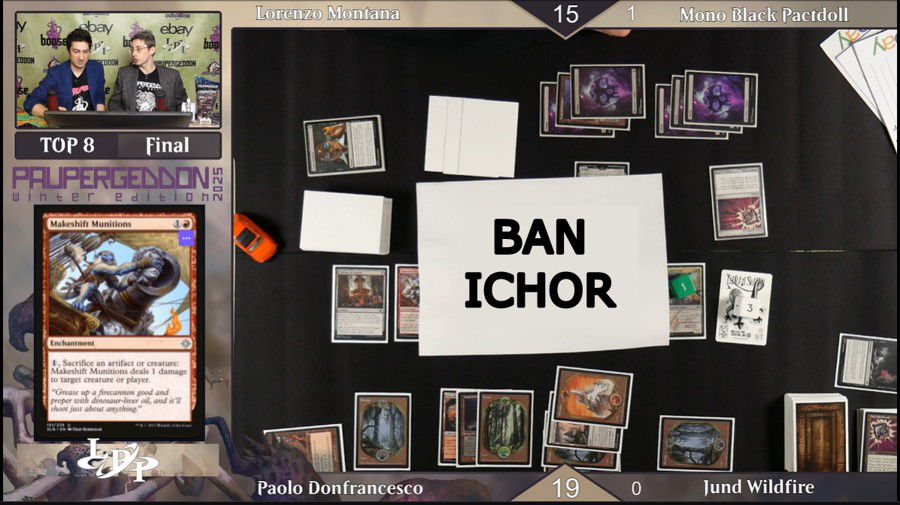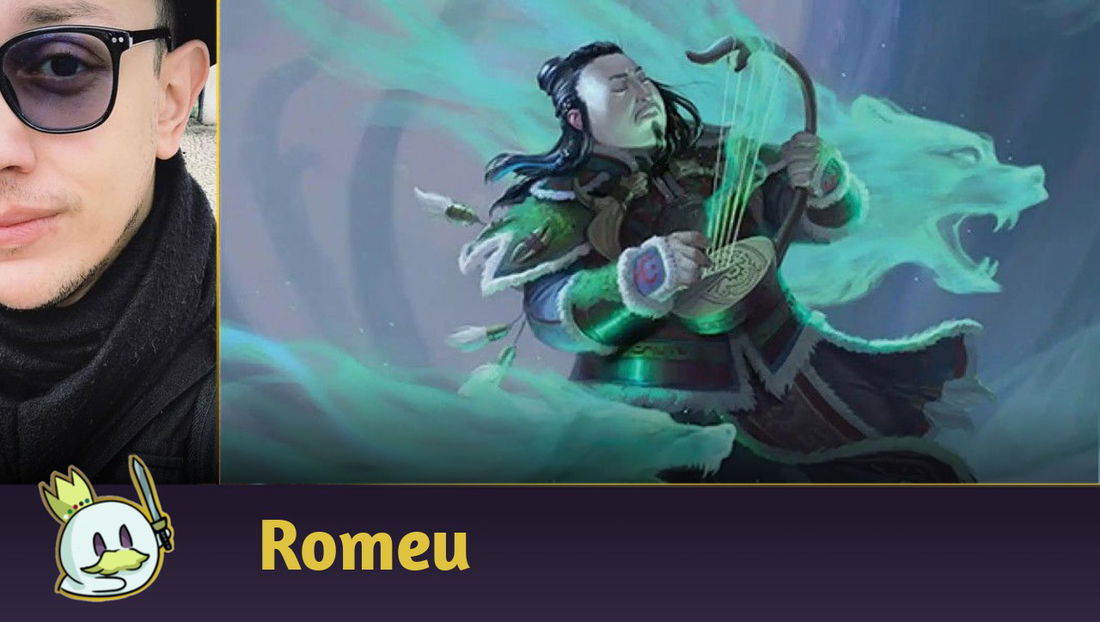Last weekend, the Pauper community gathered again for the 2025 edition of Paupergeddon, one of the format's most important tabletop events, attended by 751 players.
With an imminent ban update coming on March 31, the event was Pauper's last “trial by fire” regarding the possibility of any cards leaving the format at the end of the month, and without a statement from the PFP regarding bans so far (this article is being written on March 26), there are no expectations that interventions will occur any time soon.
Ad
Paupergeddon can be considered the most important event of the format this year, and in this article we analyze what trends it presents for the Metagame, the changes it can cause in Pauper and, possibly, also in the Banned list.
Metagame Share and Conversion
A complete spreadsheet of the Metagame and conversion of archetypes for Day 2 of the event was shared on social media, and from it, we can conclude some relevant points concerning Pauper's health and the current best decks.
Jund Wildfire is the new Goodstuff
The most played archetype of the event, to the surprise of some, was Jund Wildfire, a deck that mixes the already known interactions of decks like Affinity with Writhing Chrysalis to win games, making it a very efficient Midrange.
In many ways, Jund Wildfire harks back to the deckbuilding philosophy seen in other archetypes that have become known as “Goodstuff”—the idea of mixing the best cards of the format into a list because everything you do is so powerful and/or so synergistic that you’ll eventually win the game. In practice, it’s the best you can do in the format every turn.
The last time we saw a Goodstuff of this type was with the release of Modern Horizons, where Arcum’s Astrolabe and Ephemerate created an archetype that mixed the interactions of Kor Skyfisher with the artifact, with Skred as the best removal, Spellstutter Sprite as the best disruption, and the interaction of Mulldrifter with Ephemerate as the best source of card advantage at the time.
Wildfire essentially follows the same mold: it jhs Deadly Dispute and Ichor Wellspring as the best source of card advantage in the format, added to the interaction of Cleansing Wildfire and Bridges which are the most efficient mana ramp, Krark-Clan Shaman as the best board interaction, Refurbished Familiar as the best disruption and, of course, Writhing Chrysalis, the best creature in the current Metagame - not to mention the various interactions between its cards, such as Nyxborn Hydra and Chrysalis, or Blood Fountain and Refurbished Familiar, among others.
The result was clear: with 88 copies on Day 1, its conversion to Day 2 was positive and demonstrated that Jund is one of the best options for the format today, and a better Midrange than Affinity in its own category, as proven by its high conversion to the Top 8.
The Broodscale Dilemma

The Basking Broodscale / Sadistic Glee combo, if both variants are added together, was the most played archetype in the tournament and its conversion was not bad, but it points out that trying to be the Midrange while closing the combo makes it less efficient than the Golgari versions that are more dedicated to combining A and B to win: overall, 
Ad
Kuldotha Red and Prepared Decks

It is common to read on social media about how Kuldotha Red is an unfair deck because it is too fast, and also due to its wide popularity in Magic Online Leagues. Its conversion for Day 2 was one of the highest in Paupergeddon 2025, with 35.59%, which reinforces the idea that this is a predominant strategy.
However, Kuldotha had one of the worst conversions for the Top 32 of the tournament, with only two copies, while representing 13% of the archetypes on Day 2. The reasons may vary, but the most likely was that the decks with the highest conversion on Day 2 tend to have more efficient answers against it, such as the aforementioned Jund Wildfire and Broodscale Combo.
Furthermore, the Paupergeddon Metagame was quite broad and included archetypes ranging from the most well-known to innovative lists like Esper Ephemerate or Dark Jeskai, and it is natural that Kuldotha Red would prey on these strategies that tried too many things, were too slow, or were not thoroughly prepared to deal with Aggro, putting it in a “trial” position that prevented many archetypes from entering Day 2.
As more well-established, well-constructed archetypes and as the right card selection in the hands of more skilled players emerged, the results got worse for Kuldotha, culminating in only two copies in the Top 32 (and none in the Top 16) out of the 19 who made it to the second day playing it.
An Absent Affinity

Known as one of the format's pillars today, Grixis Affinity was noticeably absent from high representation in the Metagame, being the eighth most played archetype, with 35 copies on Day 1 and eight on Day 2.
The low numbers didn't stop it from achieving good results: with one copy in the Top 8 and another in the Top 16, Grixis Affinity still proves itself to be a viable competitor in the Metagame, but it may be a few steps behind the new Jund Wildfire, especially because it is more susceptible to targeted hate and also since it forgoes running Pauper's Tarmogoyf.
Paupergeddon's Top 32
Paupergeddon 2025 Top 32 included the following decks.
| Qty. | Deck |
|---|---|
| 6 | Jund Wildfire |
| 5 | Golgari Broodscale |
| 4 | Mono Blue Faeries |
| 3 | Jund Broodscale |
| 2 | Grixis Affinity |
| 2 | Gruul Ramp |
| 2 | Kuldotha Red |
| 2 | Mono Black Pactdoll |
| 2 | Golgari Gardens |
| 1 | Dimir Faeries |
| 1 | Dimir Terror |
| 1 | Dredge |
| 1 | Cycling Storm |
And the Top 8 was made up of 3 Jund Wildfire, 1 Golgari Gardens, 1 Mono Blue Faeries, 1 Golgari Broodscale, 1 Jund Broodscale and 1 Grixis Affinity.
The highlight besides Wildfire is the tournament-winning deck, a Golgari Gardens variant that proves, along with other Mono Black lists in the Top 16 and 32, that Pactdoll Terror is here to stay.
Ad
It has an efficient cost, a good body, strong interaction with several core cards in the current Metagame and is a decent threat on its own, which benefits greatly from the quality of black cards that create artifact tokens today and the high recursion that Midrange archetypes can have in the format.
Overall, the Jund Wildfire lists in the Top 8 follow very similar patterns, with some changes occurring between including Crypt Incursion and Pilfer, or some one-ofs in the Sideboard.
The most relevant highlight - and perhaps the most important from Paupergeddon 2025 - was Hunter's Blowgun, an artifact that doesn't see much play in Pauper today, but offers a permanent Deathtouch effect to go along with Krark-Clan Shaman, making it a bit more efficient than Toxin Analysis in its category, and proving that there is still room for unexplored interactions in Pauper.
This same interaction was also in the Grixis Affinity Top 8 list, and with Faeries once again being a rising archetype, the Reach ability that Hunter's Blowgun offers on the opponent's turn is a huge plus.
Faeries even secured a Top 8 slot with a classic Mono Blue shell, without many surprises or unique techs that could shape the format in the future, showing that it is still a safe choice.
The Golgari Broodscale list has some interesting one-ofs: I like Troublemaker Ouphe as a maindeck answer against artifacts and enchantments in this case, but Vines of Vastwood instead and a fourth Tamiyo’s Safekeeping as a way to offer a clock feels a bit off.
Sylvok Lifestaff has been resurfacing in Pauper after the Mono Black Aristocrats results as a way to guarantee extra gas against Aggro and, when you are playing a combo, all you want is to have a few more turns to close it.
The Sylvok Lifestaff tech was also on the Jund Broodscale list, as were the Sandstorm copies, although 
What can we conclude from the event?
The Paupergeddon results basically prove some points that have been clear for a while: the Deadly Dispute engine is too efficient and the format is being dictated, in part, by how well you extract value from this card.
Seven of the eight decks in the Top 8 were, in essence, Dispute archetypes. Its interaction with Ichor Wellspring turns it into Ancestral Recall, and even without it, Dispute functions as efficient manafixing and card advantage in the same slot - ultimately, there is no better value engine in the format today.

The debate around banning Deadly Dispute tends to revolve around the fact that it comes with a built-in Lotus Petal and there are several viable replacements for it, such as Fanatical Offering, Eviscerator’s Insight and Reckoner’s Bargain - none of them generate mana, but they all come with a benefit.
Ad
Somehow, it’s somewhere in the middle between being a Treasure Cruise with fewer bad topdecks, and being a Preordain: the card that glues together several archetypes in the current format and many would be much worse off without it. In that case, maybe that piece of paper in the event finals had the solution.

We don’t usually elaborate on Ichor Wellspring as a ban-worthy card because it doesn’t do much on its own. Removing it from the format would be a direct strike on all Deadly Dispute archetypes without killing any of them.

On the other hand, Wellspring is not the only card that generates extra value with Deadly Dispute: Shambling Ghast and Experimental Synthesizer exist and produce very similar results, creating again the issue of there being “other cards that do almost the same thing” that could replace a ban target.
This dilemma that Pauper is currently facing is one of the most complex in the format. It's not broken, but it's homogenized enough to the point where it's not as fun for some, while the Deadly Dispute engine is the major motivator for creating archetypes, as was the case with Jund Wildfire, Golgari Gardens, and more recently with the Mono Black Aristocrats and Pactdoll Terror lists.
There's a lack of cards with the same potential in other colors, or pieces that justify giving up Dispute and Ichor in favor of other micro-interactions. It's difficult to ban something under these circumstances without ending up unbalancing the Metagame, while at the same time, you can't just give in to popular pressure and use the hammer on cards just because people don't like them.
We'll have to wait until March 31st to find out what the future holds for Pauper. Until then, my watchlist for the format includes:

If any of these leave the format by the end of the month, I'll take it as a win. Or maybe not.









— 评论0
成为第一个发表评论的人